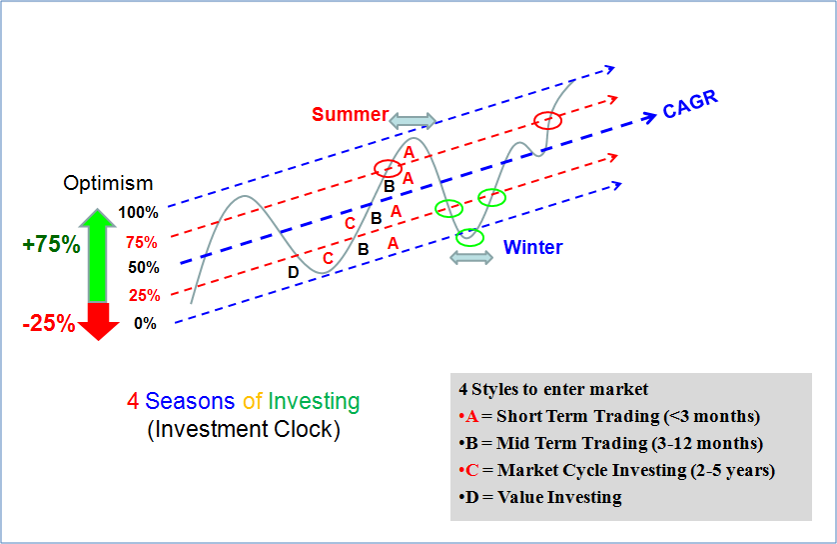
There are three schools of thought to achieve the best of both worlds in stock trading and investing. To bridge these three schools of thought, i.e. Fundamental Analysis (FA: business and economic performance), Technical Analysis (TA: price movement) and Personal Analysis (PA: emotional management), I have formulated the Optimism Strategies.
The essence of the optimism strategies is to identify fundamentally strong stocks, and buy/sell at a time aligned with technical analysis indicators, matching our personalities to take the right actions: Buy, Hold, Sell, Wait, Short.
It may seem hard to practise the above when pessimism is looming over the markets, but as investors, we all need a bit of optimism.
To make things simpler, I measure optimism on a 0 to 100% scale, where 0% stands for fearfulness or extreme pessimism, and 100% stands for greed or extreme optimism.
The general aim of investors is to find the best time for entry or exit by applying the Optimism Strategy at four different levels: Level 1 – individual stocks, Level 2 – sector/ industry, Level 3 – country/region, and Level 4 – world.
However, most undisciplined retail investors would simply follow the herd mentality—buying when everyone is buying and selling when everyone is selling. But again, these people usually end up buying high and selling low, and thus losing in investment.
Don’t be Thrown Off by the Word “Crisis”
I think a very important part of being optimistic is to not be afraid of crises, and not be distracted by “what everyone is saying”, because every crisis presents an opportunity.
If we were to observe how frequently crises occur, we will find that Level-1 crises happen almost all the time. Wind ups happen for weak companies when the earnings, assets, and/or cash flow are insufficient to pay for the debt. This could happen very unexpectedly; such was the case for Swiber.
Level-2 crises tend to follow the market cycle of the particular sector, for example oil & gas, casino, etc. But that also means that opportunities can be found every few months.
Level-3 crisis could happen every year, e.g. the US losing AAA credit rating (2011), China stock crisis (2015), Brexit crisis (2016), etc.
Level-4 crisis is even bigger in scale, but less frequent as well. Picture the Dotcom Bubble (2001) and Subprime Crisis (2008).
The above sound scary, don’t they? But I think that the greatest investment opportunities lie in the most fearful and most unexpected financial crises. This brings me to the next point.
The 4 Seasons of Investing
Of course, I don’t mean seasons in the literal sense, neither am I referring to the quarters in a year.
I use seasons as an analogy to describe market optimism. Winter is cold and seemingly lifeless, so I use it to represent a time/period when investors’ interest is very low (Optimism < 25%).
Summer, on the other hand, is hot and vibrant. I use it to represent a time when investors’ interest is high (Optimism > 75%).
Spring and autumn are seasons with milder climates, thus these two seasons refer to times when investors’ interest is average.
Needless to say, seasons come in cycles. Knowing that the market neither prospers nor stagnates forever, our aim is to enter investment in “winter” (when others are fearful), and exit in “summer” (when others are greedy).
Based on the concept of the four seasons, I have formulated a strategy to pick the optimum times of entering or exiting the market, as depicted in the diagram below:

If you are unsure about what this diagram means, I will be giving a more detailed breakdown of the approach investors can take in my free investment course.
If you’re interested to learn more, you may stay tune to my upcoming articles in this space or even attend a free investment course where I would explain the concepts more in-depth. During the free 3hr high-quality short course to the public, I will also share about 5 out of my 55 investment styles. Click on the button below to find out more about the latest upcoming workshop.
